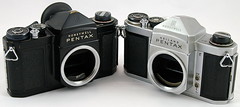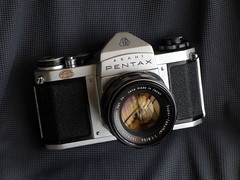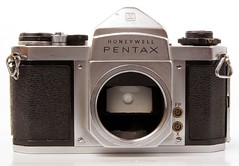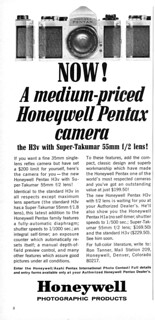Difference between revisions of "Pentax (original)"
(replaced broken SV photo, added colour var photo) |
(lost image replaced) |
||
| (34 intermediate revisions by 5 users not shown) | |||
| Line 1: | Line 1: | ||
{{Flickr_image | {{Flickr_image | ||
| − | |image_source= | + | |image_source= https://www.flickr.com/photos/hexenmeister2011/26305337274/in/pool-camerawiki/ |
| − | |image= | + | |image= https://live.staticflickr.com/7795/26305337274_1db0edb354_w_d.jpg |
|image_align= right | |image_align= right | ||
|image_text= Pentax S3 | |image_text= Pentax S3 | ||
| − | |image_by= | + | |image_by= Oğuz Ofluoğlu |
|image_rights= with permission | |image_rights= with permission | ||
}} | }} | ||
| − | The '''Asahi Pentax''', to camera collectors, the '''AP''', was a major progress in the [[35mm]] [[SLR]] field of cameras when introduced in 1957. | + | The '''Asahi Pentax''', to camera collectors, the '''AP''', was a major progress in the [[35mm]] [[SLR]] field of cameras when introduced in 1957. [[Pentax |Asahi Optical]] created the first “modern” Japanese camera, combining a pleasing body design, a pentaprism, and easily handled controls, with the [[M42]] lens mount. The existing [[Takumar]] lenses for the Asahiflex were adapted for the new mount. |
| − | + | ===Asahi Pentax AP=== | |
| − | The | + | This camera was introduced in 1957 and was a new design and improvements from the [[Asahiflex]] line. |
| + | |||
| + | From the outside, it is surprisingly similar to its predecessor, the [[Asahiflex]], sharing the size and shape of the body casting, which continued being similar on its successors right up to the last [[Spotmatic]] and the first cameras with K bayonet lenses. The key feature is the [[pentaprism]], greatly improving the [[viewfinder]] over the reversed image hard-to-follow [[Viewfinder#Waist_level_finders|waist-level finder]], and its name reflects this fact. It is by no means the first SLR using the pentaprism, but it is certainly the first easily handled camera of its kind, sporting a fast operated wind lever, and rewind knob with a small fold-able rewind crank handle. | ||
| − | The | + | Still rooted in early camera design, it lacks a few conveniences which are later taken for granted. The most obvious one being slow speed dial at the front, a manual preset lens, and a manual reset external frame counter, but apart from that nothing much sets it apart from cameras made close to two decades later. In models soon to follow, those features would be added one by one. |
| + | ===Asahi Pentax S=== | ||
| + | The '''Asahi Pentax S''' was launched the following year, in 1958. It has the standardized shutter speed sequence as the only significant improvement. | ||
| + | |||
| + | ===Asahi Pentax K=== | ||
| + | The '''Asahi Pentax K''' was introduced the same year at the 1958 [[Photokina]] in Cologne as the successor to the previous model. It has an automatic aperture stop down mechanism operating on a new range of [[Takumar#Auto_Takumar|Auto-Takumar]] lenses. These lenses must be manually cocked to stay open and to stop down automatically. They have a chrome knob on the side. A moving plate at the base inside the camera lens mount pushes a pin protruding from the back of the lens to close the lens. The shutter top speed was increased to 1/1000 second. | ||
| + | {|class=floatleft | ||
| + | | | ||
| + | {{Flickr_image | ||
| + | |image_source= https://www.flickr.com/photos/wolf-t/4760161307/in/pool-camerawiki/ | ||
| + | |image=https://live.staticflickr.com/4096/4760161307_85cfef0a2a.jpg | ||
| + | |image_align= | ||
| + | |image_text= Asahi Pentax AP and Asahi Pentax K | ||
| + | |image_by= wolf4max | ||
| + | |image_rights= non-commercial | ||
| + | }} | ||
| + | |}{{br}} | ||
| + | ===Asahi Pentax S2/H2=== | ||
The '''Asahi Pentax S2''' / '''H2''' came out in the autumn of 1959, introducing a single stationary shutter-speed dial. The slow speed dial at the camera front is gone. The camera was available in chrome or black finish. Among the improvements is a Fresnel focusing screen with a central [[micro-prism]] spot, but the 1/1000 sec top speed was gone. The US distributor was now the Heiland division of the [[Honeywell| Corporation]], and the model accordingly engraved H2 on the top plate, and soon the Asahi name was replaced by Heiland on the prism housing. A tiny indicator window next to the shutter release showing red when the camera is wound was introduced with this model, a feature that is found on every model including the 1975 series [[Pentax KM|KM]], [[Pentax KX|KX]] and [[Pentax K1000|K1000]], but is left out on K2. | The '''Asahi Pentax S2''' / '''H2''' came out in the autumn of 1959, introducing a single stationary shutter-speed dial. The slow speed dial at the camera front is gone. The camera was available in chrome or black finish. Among the improvements is a Fresnel focusing screen with a central [[micro-prism]] spot, but the 1/1000 sec top speed was gone. The US distributor was now the Heiland division of the [[Honeywell| Corporation]], and the model accordingly engraved H2 on the top plate, and soon the Asahi name was replaced by Heiland on the prism housing. A tiny indicator window next to the shutter release showing red when the camera is wound was introduced with this model, a feature that is found on every model including the 1975 series [[Pentax KM|KM]], [[Pentax KX|KX]] and [[Pentax K1000|K1000]], but is left out on K2. | ||
| − | + | {|class=floatleft | |
| + | | | ||
| + | {{Flickr_image | ||
| + | |image_source= https://www.flickr.com/photos/127540935@N08/29674669193/in/pool-camerawiki/ | ||
| + | |image=https://live.staticflickr.com/5721/30005826930_66f6018da4_m.jpg | ||
| + | |image_align= | ||
| + | |image_text= Asahi Pentax H2 (Silver) | ||
| + | |image_by= yashicasailorboy | ||
| + | |image_rights= wp | ||
| + | }} | ||
| + | | | ||
| + | {{Flickr_image | ||
| + | |image_source= https://www.flickr.com/photos/127540935@N08/30005826930/in/pool-camerawiki/ | ||
| + | |image= https://live.staticflickr.com/5581/29674669193_a9357be6dc_m.jpg | ||
| + | |image_align= | ||
| + | |image_text= Asahi Pentax H2 (Silver) | ||
| + | |image_by= yashicasailorboy | ||
| + | |image_rights= wp | ||
| + | }} | ||
| + | |} | ||
| + | {{br}} | ||
| + | ===Asahi Pentax S3 / H3=== | ||
The '''Asahi Pentax S3''' / '''H3''' was presented at the 1960 Photokina. Again it features the 1/1000 sec top shutter speed and a faster Auto-Takumar1: 1.8 / 55mm standard lens. During its production run, the clip on Asahi Pentax Meter became available, requiring a notch in the shutter-speed dial to engage. Its scale indicates directly the aperture value to be set at the lens. | The '''Asahi Pentax S3''' / '''H3''' was presented at the 1960 Photokina. Again it features the 1/1000 sec top shutter speed and a faster Auto-Takumar1: 1.8 / 55mm standard lens. During its production run, the clip on Asahi Pentax Meter became available, requiring a notch in the shutter-speed dial to engage. Its scale indicates directly the aperture value to be set at the lens. | ||
| − | {{Flickr_image | + | {| |
| + | | | ||
| + | |{{Flickr_image | ||
|image_source= http://www.flickr.com/photos/ebelbeb/4858131858/in/pool-camerawiki/ | |image_source= http://www.flickr.com/photos/ebelbeb/4858131858/in/pool-camerawiki/ | ||
|image= http://farm5.staticflickr.com/4122/4858131858_756621d704_m.jpg | |image= http://farm5.staticflickr.com/4122/4858131858_756621d704_m.jpg | ||
| Line 27: | Line 69: | ||
|image_by= ebelbeb | |image_by= ebelbeb | ||
|image_rights= non-commercial | |image_rights= non-commercial | ||
| − | }} | + | |}} |
| − | + | | | |
| + | |{{Flickr_image | ||
| + | |image_source=https://www.flickr.com/photos/vox/52565461414/in/pool-camerawiki/ | ||
| + | |image=https://live.staticflickr.com/65535/52547317770_acd08bddca_n.jpg | ||
| + | |image_align= | ||
| + | |image_text= Heiland Pentax H-3 Ad<br> | ||
| + | |scan_by= Voxphoto | ||
| + | |image_rights= nc | ||
| + | |}} | ||
| + | |} | ||
| + | ===Asahi Pentax S1/H1=== | ||
The '''Asahi Pentax S1''' / '''H1''' was launched in 1961 as a compliment to the previous model. The fastest speed indicted on the shutter-speed dial is 500, while still working at 1/1000 sec. It was removed for marketing reasons, as was the faster 1:1.8 lens. It was replaced by the slower 1:2 aperture standard lens, permitting a lower sales price to meet the competition, while the provision for the exposure meter was retained. The semi-automatic lens must be manually cocked to stay open and to stop down to the pre-selected aperture when the shutter is released. | The '''Asahi Pentax S1''' / '''H1''' was launched in 1961 as a compliment to the previous model. The fastest speed indicted on the shutter-speed dial is 500, while still working at 1/1000 sec. It was removed for marketing reasons, as was the faster 1:1.8 lens. It was replaced by the slower 1:2 aperture standard lens, permitting a lower sales price to meet the competition, while the provision for the exposure meter was retained. The semi-automatic lens must be manually cocked to stay open and to stop down to the pre-selected aperture when the shutter is released. | ||
| + | {| | ||
{{Flickr_image | {{Flickr_image | ||
|image_source= http://www.flickr.com/photos/vox/4803129436/in/pool-camerawiki/ | |image_source= http://www.flickr.com/photos/vox/4803129436/in/pool-camerawiki/ | ||
| Line 39: | Line 92: | ||
|image_rights= non-commercial | |image_rights= non-commercial | ||
}} | }} | ||
| + | |- | ||
| + | | | ||
| + | {{Flickr_image | ||
| + | |image_source=https://www.flickr.com/photos/vox/52565461414/in/pool-camerawiki/ | ||
| + | |image=https://live.staticflickr.com/65535/52565461414_c2000ee293_n.jpg | ||
| + | |image_align= left | ||
| + | |image_text= Heiland Pentax H1 Ad | ||
| + | |scan_by= Voxphoto | ||
| + | |image_rights= non-commercial | ||
| + | }} | ||
| + | |} | ||
{{br}} | {{br}} | ||
| − | |||
| + | ===Asahi Pentax SV/H3v=== | ||
| + | The '''Asahi Pentax SV''' / '''H3v''' was launched in 1962 (Product Nbr 232, 23200). The standard lens is the Super-Takumar f/1.8 and in the USA the f/2.0 / 55mm was offered as an economical alternative. | ||
| + | |||
| + | This camera was the first to have fully automatic aperture operation together with the [[Takumar#Super-Takumar_Lenses|Super-Takumar lenses]]. The other innovation on this model was the addition of a self-timer ('''V'''). It is situated under the rewind knob with an integral film reminder dial. A curved arrow and a chrome release button on the top plate next to it complement the function. A yellow engraved V on the dial indicates when the picture will be taken as seen from the camera front. Thus the name SV or H3v (USA) | ||
| + | A new automatic resetting frame counter is placed under a cover on top of the wind-lever hub. | ||
| + | |||
| + | Later models were modified for the Super Takumar f/1.4 50 by changing the aperture mechanism and those are marked with an orange R in the rewind crank. | ||
| + | |||
| + | {|class=floatleft | ||
| + | | | ||
{{Flickr_image | {{Flickr_image | ||
|image_source= http://www.flickr.com/photos/98922823@N00/8541020103/in/pool-camerawiki/ | |image_source= http://www.flickr.com/photos/98922823@N00/8541020103/in/pool-camerawiki/ | ||
|image= http://farm9.staticflickr.com/8390/8541020103_c0024462f9_m.jpg | |image= http://farm9.staticflickr.com/8390/8541020103_c0024462f9_m.jpg | ||
| − | |image_align= | + | |image_align= center |
|image_text= Asahi Pentax SV chrome | |image_text= Asahi Pentax SV chrome | ||
|image_by= Paulo Moreira | |image_by= Paulo Moreira | ||
|image_rights= wp | |image_rights= wp | ||
}} | }} | ||
| − | + | | | |
{{Flickr_image | {{Flickr_image | ||
|image_source= http://www.flickr.com/photos/wolf-t/8597866289/in/pool-camerawiki/ | |image_source= http://www.flickr.com/photos/wolf-t/8597866289/in/pool-camerawiki/ | ||
|image= http://farm9.staticflickr.com/8381/8597866289_2f1aa966c3_m.jpg | |image= http://farm9.staticflickr.com/8381/8597866289_2f1aa966c3_m.jpg | ||
| − | |image_align= | + | |image_align= center |
|image_text= Asahi Pentax SV black | |image_text= Asahi Pentax SV black | ||
|image_by= wolf4max | |image_by= wolf4max | ||
|image_rights= non-commercial | |image_rights= non-commercial | ||
}} | }} | ||
| − | + | |- | |
| + | | | ||
{{Flickr_image | {{Flickr_image | ||
|image_source= http://www.flickr.com/photos/martintaylor/47712649/in/pool-camerawiki/ | |image_source= http://www.flickr.com/photos/martintaylor/47712649/in/pool-camerawiki/ | ||
|image= http://static.flickr.com/27/47712649_8ceda2862b_m.jpg | |image= http://static.flickr.com/27/47712649_8ceda2862b_m.jpg | ||
| − | |image_align= | + | |image_align= center |
|image_text= Honeywell Pentax H3v | |image_text= Honeywell Pentax H3v | ||
|image_by= Martin Taylor | |image_by= Martin Taylor | ||
|image_rights=nc | |image_rights=nc | ||
}} | }} | ||
| + | | | ||
| + | {{Flickr_image | ||
| + | |image_source=https://www.flickr.com/photos/vox/51339919842/in/pool-camerawiki/ | ||
| + | |image=https://live.staticflickr.com/65535/51339919842_69d52198e7_n.jpg | ||
| + | |image_align= center | ||
| + | |image_text= Honeywell Pentax H3v Ad | ||
| + | |scan_by= Voxphoto | ||
| + | |image_rights=nc | ||
| + | }} | ||
| + | | | ||
| + | |} | ||
| + | {{br}} | ||
| + | This camera was famously used by the Beatles in a Hard's Day Night movie, where Asahi used these cameras as promotion. | ||
{{br}} | {{br}} | ||
| + | |||
| + | ===Asahi Pentax S1a/H1a=== | ||
The '''Asahi Pentax S1a''' / '''H1a''' is the economy complement to the SV, at a 20% discount. It lacked the self-timer and came with the Super-Takumar 1:2 / 55mm lens. As on the S1, it also has a hidden 1/1000 sec. shutter speed, and the lens is optically not different from the 1:1.8 version. | The '''Asahi Pentax S1a''' / '''H1a''' is the economy complement to the SV, at a 20% discount. It lacked the self-timer and came with the Super-Takumar 1:2 / 55mm lens. As on the S1, it also has a hidden 1/1000 sec. shutter speed, and the lens is optically not different from the 1:1.8 version. | ||
This concludes the so-called S-family of Pentax cameras, followed in 1964 by the [[Spotmatic]] family. These S-cameras are sturdy and dependable still after half a century if cared for, and are just as capable now as they were back then. It is always a joy to pick up one and know the shutter still fires correctly. | This concludes the so-called S-family of Pentax cameras, followed in 1964 by the [[Spotmatic]] family. These S-cameras are sturdy and dependable still after half a century if cared for, and are just as capable now as they were back then. It is always a joy to pick up one and know the shutter still fires correctly. | ||
| + | ===Accessories=== | ||
| + | {|class=floatright | ||
| + | {{Flickr_image | ||
| + | |image_source= https://www.flickr.com/photos/89853469@N00/6834685599/in/pool-camerawiki | ||
| + | |image= https://live.staticflickr.com/7018/6834685599_e36c29ef65_m.jpg | ||
| + | |image_align= right | ||
| + | |image_text= Pentax SV <br>with Lightmeter | ||
| + | |image_by=Pablo Coronel | ||
| + | |image_rights= with permission | ||
| + | }} | ||
| + | |} | ||
The '''Asahi Pentax Meter''', is a separately available CdS exposure meter that clips on to the finder eyepiece frame, sitting on top of the finder housing. The first version is missing a battery check position on the meter switch. These were followed later by a somewhat clumsy rectangular one, which must not be confused with a similar meter made available for the meter-less Spotmatic SL on which the shutter-speed dial is differently situated. | The '''Asahi Pentax Meter''', is a separately available CdS exposure meter that clips on to the finder eyepiece frame, sitting on top of the finder housing. The first version is missing a battery check position on the meter switch. These were followed later by a somewhat clumsy rectangular one, which must not be confused with a similar meter made available for the meter-less Spotmatic SL on which the shutter-speed dial is differently situated. | ||
| + | {{br}} | ||
| + | |||
| + | ==Links== | ||
| + | *[https://www.butkus.org/chinon/pentax/asahi_pentax/asahi_pentax.htm Asahi Pentax user manual] at [https://www.butkus.org/chinon/ Butkus.org] | ||
| + | * [https://www.butkus.org/chinon/pentax/asahi_pentax_s/asahi_pentax_s.htm Asahi Pentax S PDF manual] at [https://www.butkus.org/chinon/index.html www.OrphanCameras.com] | ||
| + | *[https://www.butkus.org/chinon/pentax/asahi_pentax_k/asahi_pentax_k.htm Asahi Pentax K user manual] at [https://www.butkus.org/chinon/ Butkus.org] | ||
| + | *[https://www.manualslib.com/products/Pentax-Heiland-H2-622874.html Heiland Pentax H2 user manual] at [https://www.manualslib.com/ Manualslib] | ||
| + | *[https://www.butkus.org/chinon/pentax/pentax_s1_s3/pentax_s1_s3.htm Pentax S1 and S3 user manual] at [https://www.butkus.org/chinon/ Butkus.org] | ||
| + | *[https://www.butkus.org/chinon/pentax/pentax_sv_s1a/pentax_sv_s1a.htm Pentax SV and S1a user manual] at [https://www.butkus.org/chinon/ Butkus.org] | ||
| + | *[https://www.butkus.org/chinon/flashes_meters/asahi_pentax_clip-on/asahi_pentax_clip-on.htm Asahi Pentax Clip-on meter user manual] at [https://www.butkus.org/chinon/ Butkus.org] | ||
| + | * [https://www.butkus.org/chinon/pentax.htm Pentax PDF manuals] at [https://www.butkus.org/chinon/index.html www.OrphanCameras.com] | ||
| + | |||
[[Category: Japanese 35mm SLR]] | [[Category: Japanese 35mm SLR]] | ||
| Line 80: | Line 192: | ||
[[Category: Pentax]] | [[Category: Pentax]] | ||
[[Category: P]] | [[Category: P]] | ||
| + | [[Category: 1957]] | ||
Latest revision as of 16:46, 30 January 2024
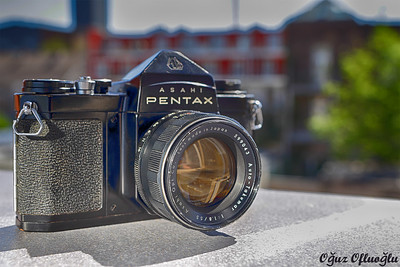
|
| Pentax S3 image by Oğuz Ofluoğlu (Image rights) |
The Asahi Pentax, to camera collectors, the AP, was a major progress in the 35mm SLR field of cameras when introduced in 1957. Asahi Optical created the first “modern” Japanese camera, combining a pleasing body design, a pentaprism, and easily handled controls, with the M42 lens mount. The existing Takumar lenses for the Asahiflex were adapted for the new mount.
Contents
Asahi Pentax AP
This camera was introduced in 1957 and was a new design and improvements from the Asahiflex line.
From the outside, it is surprisingly similar to its predecessor, the Asahiflex, sharing the size and shape of the body casting, which continued being similar on its successors right up to the last Spotmatic and the first cameras with K bayonet lenses. The key feature is the pentaprism, greatly improving the viewfinder over the reversed image hard-to-follow waist-level finder, and its name reflects this fact. It is by no means the first SLR using the pentaprism, but it is certainly the first easily handled camera of its kind, sporting a fast operated wind lever, and rewind knob with a small fold-able rewind crank handle.
Still rooted in early camera design, it lacks a few conveniences which are later taken for granted. The most obvious one being slow speed dial at the front, a manual preset lens, and a manual reset external frame counter, but apart from that nothing much sets it apart from cameras made close to two decades later. In models soon to follow, those features would be added one by one.
Asahi Pentax S
The Asahi Pentax S was launched the following year, in 1958. It has the standardized shutter speed sequence as the only significant improvement.
Asahi Pentax K
The Asahi Pentax K was introduced the same year at the 1958 Photokina in Cologne as the successor to the previous model. It has an automatic aperture stop down mechanism operating on a new range of Auto-Takumar lenses. These lenses must be manually cocked to stay open and to stop down automatically. They have a chrome knob on the side. A moving plate at the base inside the camera lens mount pushes a pin protruding from the back of the lens to close the lens. The shutter top speed was increased to 1/1000 second.
|
Asahi Pentax S2/H2
The Asahi Pentax S2 / H2 came out in the autumn of 1959, introducing a single stationary shutter-speed dial. The slow speed dial at the camera front is gone. The camera was available in chrome or black finish. Among the improvements is a Fresnel focusing screen with a central micro-prism spot, but the 1/1000 sec top speed was gone. The US distributor was now the Heiland division of the Corporation, and the model accordingly engraved H2 on the top plate, and soon the Asahi name was replaced by Heiland on the prism housing. A tiny indicator window next to the shutter release showing red when the camera is wound was introduced with this model, a feature that is found on every model including the 1975 series KM, KX and K1000, but is left out on K2.
|
|
Asahi Pentax S3 / H3
The Asahi Pentax S3 / H3 was presented at the 1960 Photokina. Again it features the 1/1000 sec top shutter speed and a faster Auto-Takumar1: 1.8 / 55mm standard lens. During its production run, the clip on Asahi Pentax Meter became available, requiring a notch in the shutter-speed dial to engage. Its scale indicates directly the aperture value to be set at the lens.
|
|
Asahi Pentax S1/H1
The Asahi Pentax S1 / H1 was launched in 1961 as a compliment to the previous model. The fastest speed indicted on the shutter-speed dial is 500, while still working at 1/1000 sec. It was removed for marketing reasons, as was the faster 1:1.8 lens. It was replaced by the slower 1:2 aperture standard lens, permitting a lower sales price to meet the competition, while the provision for the exposure meter was retained. The semi-automatic lens must be manually cocked to stay open and to stop down to the pre-selected aperture when the shutter is released.
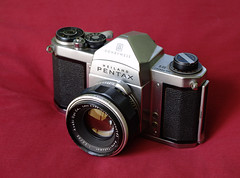
|
| Honeywell Heiland Pentax H1 image by Voxphoto (Image rights) |

|
| Heiland Pentax H1 Ad scanned by Voxphoto (Image rights) |
Asahi Pentax SV/H3v
The Asahi Pentax SV / H3v was launched in 1962 (Product Nbr 232, 23200). The standard lens is the Super-Takumar f/1.8 and in the USA the f/2.0 / 55mm was offered as an economical alternative.
This camera was the first to have fully automatic aperture operation together with the Super-Takumar lenses. The other innovation on this model was the addition of a self-timer (V). It is situated under the rewind knob with an integral film reminder dial. A curved arrow and a chrome release button on the top plate next to it complement the function. A yellow engraved V on the dial indicates when the picture will be taken as seen from the camera front. Thus the name SV or H3v (USA) A new automatic resetting frame counter is placed under a cover on top of the wind-lever hub.
Later models were modified for the Super Takumar f/1.4 50 by changing the aperture mechanism and those are marked with an orange R in the rewind crank.
|
| |||||
|
|
This camera was famously used by the Beatles in a Hard's Day Night movie, where Asahi used these cameras as promotion.
Asahi Pentax S1a/H1a
The Asahi Pentax S1a / H1a is the economy complement to the SV, at a 20% discount. It lacked the self-timer and came with the Super-Takumar 1:2 / 55mm lens. As on the S1, it also has a hidden 1/1000 sec. shutter speed, and the lens is optically not different from the 1:1.8 version.
This concludes the so-called S-family of Pentax cameras, followed in 1964 by the Spotmatic family. These S-cameras are sturdy and dependable still after half a century if cared for, and are just as capable now as they were back then. It is always a joy to pick up one and know the shutter still fires correctly.
Accessories

|
| Pentax SV with Lightmeter image by Pablo Coronel (Image rights) |
The Asahi Pentax Meter, is a separately available CdS exposure meter that clips on to the finder eyepiece frame, sitting on top of the finder housing. The first version is missing a battery check position on the meter switch. These were followed later by a somewhat clumsy rectangular one, which must not be confused with a similar meter made available for the meter-less Spotmatic SL on which the shutter-speed dial is differently situated.
Links
- Asahi Pentax user manual at Butkus.org
- Asahi Pentax S PDF manual at www.OrphanCameras.com
- Asahi Pentax K user manual at Butkus.org
- Heiland Pentax H2 user manual at Manualslib
- Pentax S1 and S3 user manual at Butkus.org
- Pentax SV and S1a user manual at Butkus.org
- Asahi Pentax Clip-on meter user manual at Butkus.org
- Pentax PDF manuals at www.OrphanCameras.com



